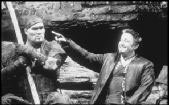SEATTLE OPERA
Seattle Center Opera House; SOLD OUT ends Sun., Aug. 26
THERE’S NO POINT in reviewing Seattle Opera’s current production of Wagner’s Ring of the Nibelungs. After all, it’s been sold out since—well, practically since their last Ring in 1995. So instead, for the benefit of those who can’t be there, I offer Seattle Opera’s 2001 Ring FAQs:
Seventeen hours?! How did you get through it?
Only people who have never seen a Ring think it’s some sort of intimidating ordeal. But the week flew by, and at five and a quarter hours, even the longest of the four operas—G�rd䭭erung, a.k.a. Goddammitslong—seemed to hurtle along, especially in the action-packed second and third acts.
Can you summarize the plot?
Das Rheingold: Dwarf Alberich steals the Rhinegold and forges the all-powerful Ring. Wotan, chief god, steals it to pay the giant Fafner for building Valhalla. Die Walkre: Siegmund meets Sieglinde; they run off and discover they’re also brother and sister. Wotan, wife Fricka, and daughter Brnnhilde argue about whether the elopement was wrong. Wotan forbids Brnnhilde from protecting Siegmund from cuckold Hunding’s revenge; she tries to anyway. Wotan de-Valkyrizes her, banishes her, and surrounds her with fire. Siegfried: Siegfried, the spawn of Siegmund and Sieglinde’s incestuous adultery, kills Fafner, gets the Ring, and rescues Brnnhilde. G�rd䭭erung: Alberich’s son Hagen causes Siegfried to betray Brnnhilde and then kills him, but he doesn’t get the Ring. Brnnhilde returns it to the Rhine. Valhalla and the gods are destroyed. (Not bad for 123 words, eh?)
I’ve heard a lot about this being a “green,” “naturalistic” Ring. What’s that about?
Nature was stunningly represented by Thomas Lynch’s incomparable sets: looming cliffs, towering tangled trees, and mossy banks filled the stage. But the production’s real focus was the characters’ personal relationships. Director Stephen Wadsworth and the cast dug deep into their tangled, emotionally complex pasts; the Ring is talky, but these confrontations were charged with an awareness of the characters’ interwoven histories and staged for maximum impact. This made the whole four-evening tale cohere beautifully and sweep right along. As magnificent as the sets were, they miraculously never overshadowed the characters’ relationships.
And the singing?
Jane Eaglen as Brnnhilde was the supreme casting coup, with a satiny soprano that she simply let loose, a powerful but unforced sound. There was a girlish streak in her portrayal that might not jive with everyone’s concept of “warrior goddess”; her strong points as an actress were expressing wounded dignity and radiant joy. Alan Woodrow’s tenor was similarly tireless, beautifully virile with a slightly baritoney weight and color. He injured a leg muscle in a fall last Tuesday, the day before he was to open in the title role of Siegfried. He sang from stage left as understudy Richard Berkeley-Steele acted and lip-synched the part. You’d have been surprised at how unobtrusive and effective this double casting was. (At press time, Seattle Opera still hadn’t decided whether they’d continue with the lip-synching, whether Berkeley-Steele would take over the part outright, or whether Woodrow would heal in time for the third cycle.) There was particular buzz over two other cast members: Stephanie Blythe as a soaring, sympathetic Fricka, and Stephen Milling as Hunding, who ruled the stage with a glowering charisma and a thundering baritone. “Future Wotan” was a phrase I heard applied to him more than once.
Any cool special effects?
The Rhinemaidens were the hit of this production, just as the mechanical dragon was of the 1995 Ring: Lisa Saffer, Mary Phillips, and Laura Tucker soared, dove, and tumbled through the air on wires that allowed a magical freedom of movement. The end of G�rd䭭erung, naturally, marked this production’s climax of stagecraft: From the hall where Siegfried lay in state, we dissolved (via artfully lit scrims) to the bottom of the Rhine, to sheets of water and fire, to a tableau of the gods in Valhalla calmly accepting their fate, then finally to another gorgeous Thomas Lynch set of a forest clearing—a reborn world, cleansed of the Ring and its curse. It was tremendously moving, and in retrospect, I marveled at the way the cast, the technical crew, and the orchestra under Franz Vote had been able to give the entire cycle a dramatic trajectory, leading from the first primeval note of Rheingold to this last transcendent scene.







